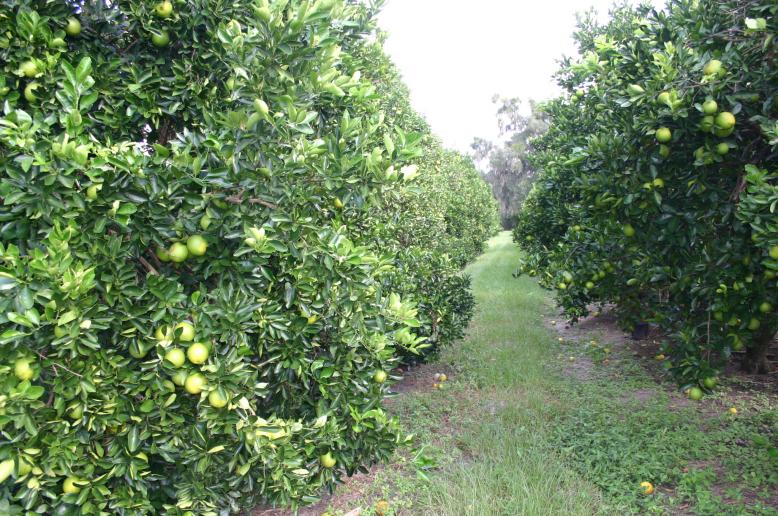Citrus Greening (HLB) Answers
From September 27, 2017 Hurricane Irma: The groves following our recommended programs fared exceptionally well during the onslaught of intense Hurricane Irma (experienced here September 10-11, 2017). Fruit losses in groves following our recommendations were relatively low based upon on-site inspections of September 21, 2017. The strong, healthy stem connections to the fruit paid off in low fruit loss in spite of 100+ mph winds.
Citrus growers – Welcome to Citrus Greening (HLB) Answers. Great news – you can bring your Citrus grove back to a healthy condition with improved fruit quality and higher production. Yes, you can reverse declines, restore tree health, promote greater production, more pound solids and maintain profitable productivity of your grove. Be sure to look below for success stories and details of our breakthrough products to include our proprietary liquid foliar treatment: energized Citra Thrive Plus 4-10-10 (with carbon as high oxygen content fulvic acid) and our energized Root Promoting 8-0-11 Fertilizer. Our testing includes a comprehensive soil test, tissue analysis, and water test as appropriate.
Important news! The Florida Department of Agriculture has documented the effectiveness of our program in an orange grove in central Florida [letter sent March 7, 2017]:
” Dana,
I got your voicemail message from yesterday……….. Our lab did indicate that the leaf samples from the Kelly Citrus LLC grove did still have Ct values that indicate the presence of citrus greening (HLB or Huanglongbing). Our head of our plant pathology section (Dr. Sun) also indicated that in general the average Ct value of an HLB infected citrus tree in Florida usually runs between 25 and 27. The average Ct value that we saw from Kelly Citrus was 30.33, which would indicate lower titers of the HLB pathogen. Our sample size is low, so we cannot definitively determine why the titers are lower. Working with some of the scientists at University of Florida SWREC on a larger more robust trial and sampling regime could paint a more a thorough picture. If you can gather data indicating increase in box count and having some rows (or some trees) that do not receive treatments for comparison will also be a good thing to illustrate.
I have attached the sample results from our lab in the form of the attached spreadsheet. Please let me know if you need additional information,
Greg
Greg Hodges, Ph.D.
Assistant Director
Division of Plant Industry
Florida Department of Agriculture and Consumer Services
Why do our programs for Citrus growers work so well?
Quality Green Has a Proven Program to Remediate Citrus Greening (HLB)
Yes, you can bring your Citrus grove back to a healthy condition with improved fruit quality and higher production. Yes, we can show you how to reverse declines, restore tree health, promote greater production, higher Brix, more pound solids and increase profitability of an under-performing, declining Citrus grove. We are assisting very satisfied commercial Citrus growers who have seen strong recovery of their groves to strong production and profitability. The keys are our high quality, detailed, comprehensive testing, our thorough recommendations, our breakthrough nutritional products, and a detailed season-long program of nutritional and disease-protecting inputs. Our proprietary products include energized Citra Thrive Plus (4-10-10 analysis) and our energized RootPro 3-7-4 that is incorporated into our recommended fertilizer blends based on the results of our comprehensive testing. Our complete testing includes a comprehensive detailed standard soil test, a saturated paste soil report, and a tissue analysis. Water testing is also performed as necessary.
We test for many minerals/elements and soil conditions other testing services do not, e.g., phosphorus by two different testing methods (Mehlich III for more readily available phosphorus and Bray 1 for tightly sequestered phosphorus), sodium along with potassium (because they are taken up identically & sodium toxicity mimics potassium deficiency), the percentage of each mineral in the base saturation of the soil (because there needs to be room for a sufficient level of all the minerals in specific holding capacity of the soil) , iron, aluminum (because of the high potential for toxicity with excessive levels), bio-available silicon dioxide (because silicon is the second most important mineral for plant growth after available carbon as fulvic acid), chlorides, bicarbonates, and other test results unique to Quality Green. We custom-blend high quality energized fertilizer for individual Citrus groves to ensure high-production and sustainability. “Energized” refers to compounds with essential elements reacted (with a process called “oxygen reduction” to add extra oxygen to their molecular structure, e.g., fulvic acid has additional oxygen in its molecular structure contrasted to humic acid making it into the only form of carbon that is bio-available and can be metabolized by plants; silicon dioxide, the bio-available form of silicon we utilize from Azomite volcanic pumice, has one more oxygen than unavailable silicon oxide that makes up sand.
We enrich our proprietary liquid foliar Citra Thrive Plus 4-10-10with all the micronutrients our comprehensive testing finds to be deficient. We include BioWash in our Citra Thrive Plus, the best penetrant/surfactant we have found, to ensure rapid penetration throughout the tree, to include the critically important root system. We include phosphite in our Citra Thrive Plus and in our granular RootPro fertilizer blends to ensure rapid systemic uptake/movement to the entire tree and to provide excellent disease control, especially against soil-born Phytophthora spp. We include over nine species of beneficial microorganisms, to include species of Bacillus and Trichoderma, to suppress the Liberobacter bacterium, the response to which causes HLB. All of our products have a high percentage of organics that are ready for immediate absorption and assimilation by Citrus and other trees and plants.
High levels of available carbon and silicon, that other programs ignore and are other fertilizers are missing, are of primary importance. We include bio-available forms of carbon (as fulvic acid) and silicon (as silicon dioxide) in our programs, the two most important elements for the growth of Citrus and other plants. Our Citra Thrive Plus includes humates with over 58% bio-available fulvic acid with the remainder as humic acid, which slowly converts to fulvic acid. Our dry fertilizer blends also include humate with 30% immediately available fulvic acid, along with longer-term release humic acid. Our dry, granular fertilizer blends include the best organic, OMRI listed volcanic pumice mineralizer (Azomite®), with over 65% bio-available silicon dioxide (unlike sand that is unavailable silicon oxide) and over 70 trace minerals.
Our programs and materials ensure sustainability. The volcanic mineralizer Azomite and our other products have lower amounts of heavy metals than most regular soils. The leaching potential of our high organics fertilizer materials (including naturally mined minerals & plant-based organics) is very low as well.
Yours for a strong Citrus industry,
Dana Venrick
President & Founder
Quality Green Specialists
Now, we invite you to see the results for yourself.
Updates: Here are photos showing dramatic improvement of groves that have received our recommended inputs for a season-long program:
Below: Photos of groves following our programs displaying dramatic recovery from Greening (HLB), also with big crops of fruit. Keep calcium (Ca), phosphorus (with foliar sprays including phosphite) & other minerals at high levels in the tree tissue (4.5% for Ca) and use the appropriate fungicides properly timed to keep the fruit on the trees. Photos taken 8-10-16. Apply the first applications of the season before bud break and bloom break for best results (usually January and not later than early February).
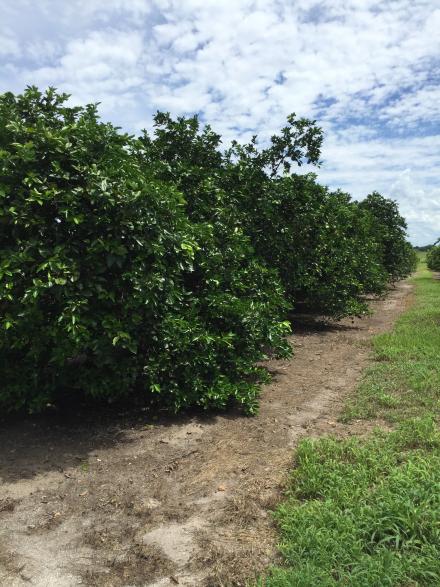
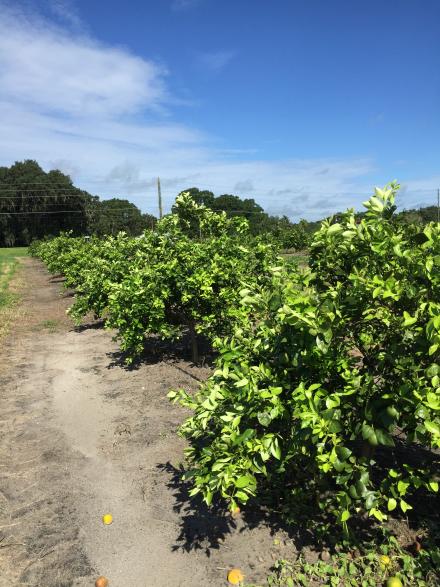
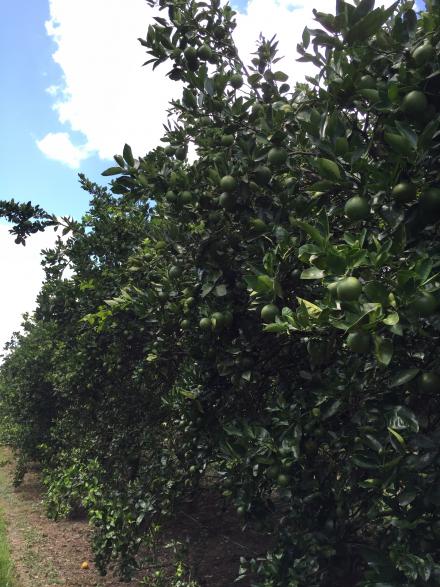
Our outstanding 8-0-11 granular fertilizer is designed to support optimum Citrus tree health and production along with our Citra Thrive Plus liquid treatment. Remember, for long-term, sustainable results, testing is of utmost importance before beginning any Citrus nutritional program. Our fertilizer recommendations are then customized to the site specific soil and tree tissue testing results.
Why does our liquid foliar treatment Citra Thive Plus 4-10-10 work so well to remediate Citrus Greening, a.k.a. HLB? Besides the super surfactant/pentetrants it contains, we employ the latest technology to energize the carbon base to create over 58% fulvic acid. (Carbon is the single most important element for plant growth ahead of silicon, hydrogen, oxygen, potassium, nitrogen, phosphorus, etc.) Citra Thrive Plus has the latest oxygen enhanced technology with the carbon humate portion having over 58% of the biologically available & metabolically active fulvic acid (as opposed to most humates having a much higher percentage of metabolically inactive humic acid).
Citra Thrive Plus achieves such a high percentage of highly active fulvic acid from a process called reduction oxidation of electrons (REDOX). REDOX is a process where as one element is oxidized, the other element is oxygen reduced. This process creates fulvic acid molecules that contain more oxygen electrons. Because fulvic acid contains more oxygen elections, the molecular weight of fulvic acid is lighter than humic acid. Those un-bonded (extra) oxygen electrons promote many natural occurring reactions in soils and more efficient metabolism within plant cells. The bottom line: plants are healthier, grow faster, nutrients flow easily, and systemic acquired resistance (SAR) is strongly boosted. Citrus trees managed with Citra Thrive Plus and our energized granular fertilizer blends regain vigorous health and have greater production of high quality fruit.
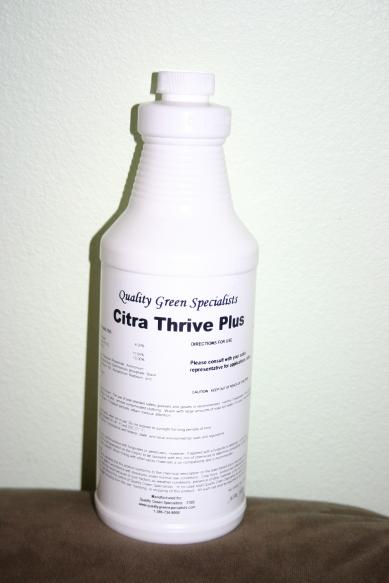
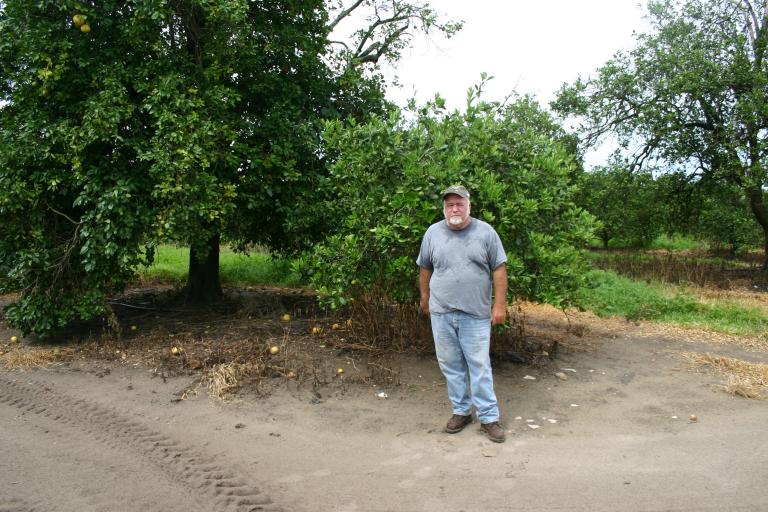
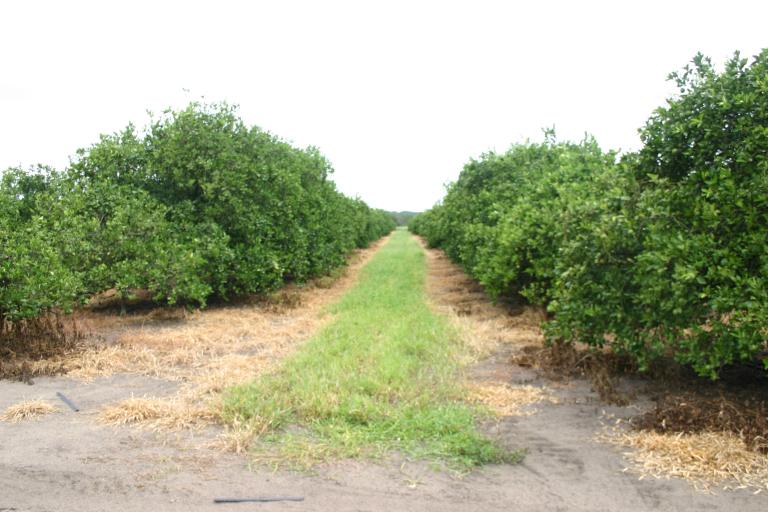

Above: Update: This is how the grove has improved even more. The trees look great and have a big crop of uniform, good-sized fruit! Photo taken 8-10-16.
Ron Kelley in his commercial grove in Bowling Green, Florida. Ron was ready to push his entire grove. Now the grove is coming back beautifully. Ron also says about his bumper crop of large, uniformly sized fruit, ” The [developing, green] fruit are as large this time of year as they were when I picked them last year”. His crop of Hamlins for 2015 increased in pound solids and total boxes harvested – the turn-around he was looking for to stay in business.
Below: Recovering young orange tree in Ron Kelley’s grove:

Two Photos Below: This is how the recovering tree pictured above (top photo) and trees in the northwest part of grove (bottom photo) looked before treatments began (photos taken 2-23-2015):
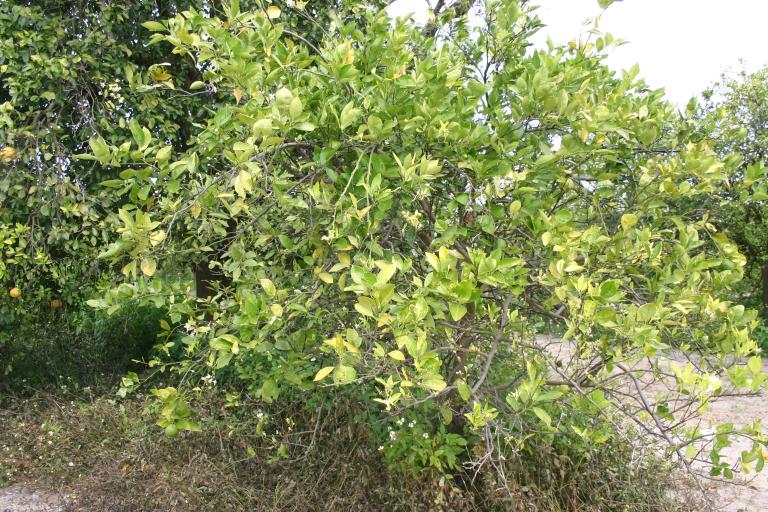
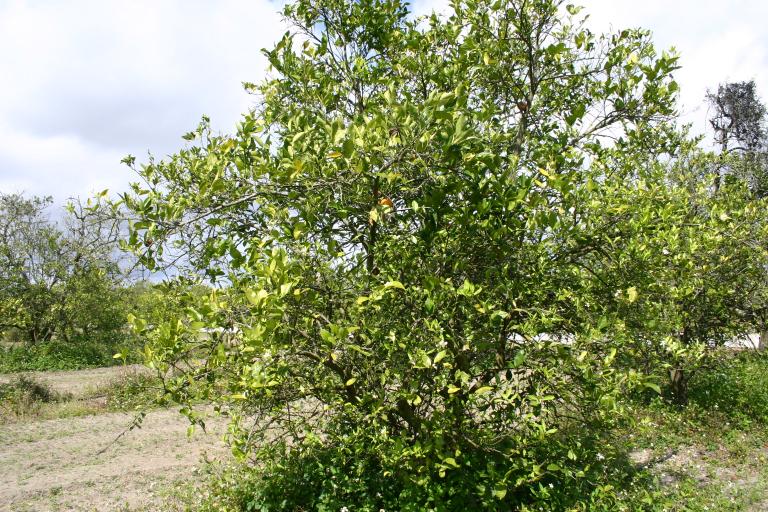
Below three photos: This is how the northwest grove area pictured in the above photo taken on 2-23-16 looks now (photos taken 8-24-16):

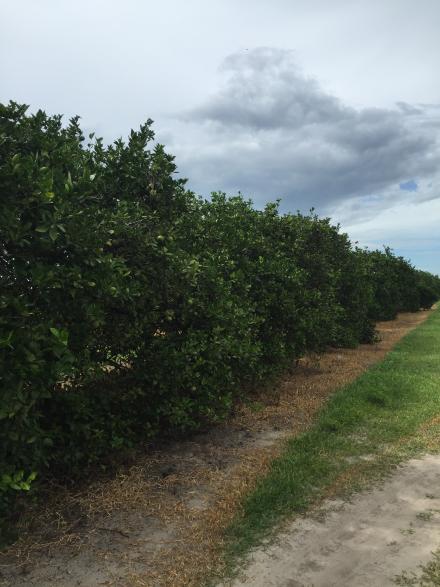
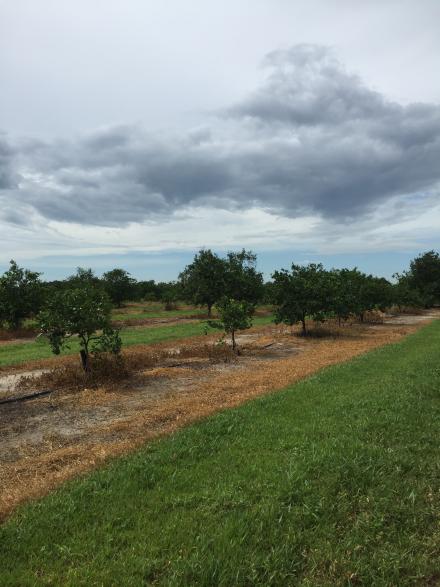
Below: Young orange trees owned by T. & C. Walker before remedial treatment was initiated. Photo taken February 18, 2015.

Below: Orange trees have recovered with remedial treatment of needed fertilizer and Citra Thrive Plus. Photo taken May 18, 2015.
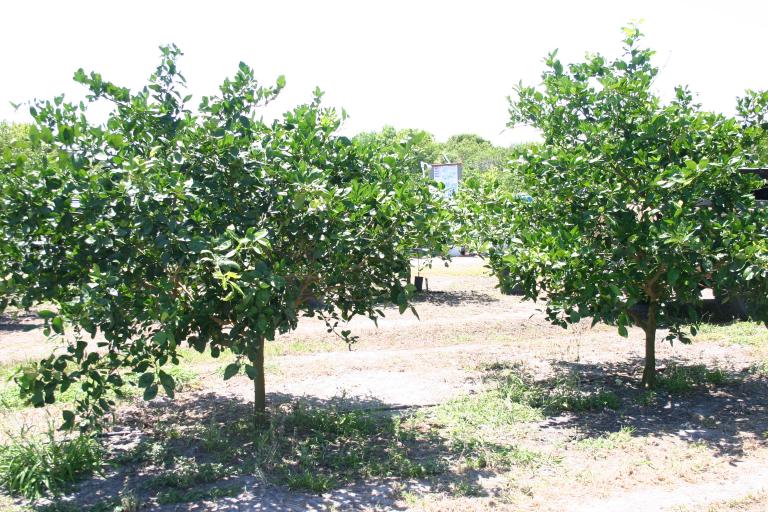
My Citrus trees were beginning to show strong symptoms of HLB (Citrus Greening Disease), and so I fertilized them with our new CitrusPro dry granular fertilizer and sprayed them with our liquid Citra Thrive Plus. All the trees are now full of some of the best, dark green new growth I have ever seen. Obviously, the trees have by-passed any phloem blockage that may have existed in the trees, the roots have recovered, and are pushing strong, healthy new growth. Here are unretouched photos (photos taken 3-13-16):
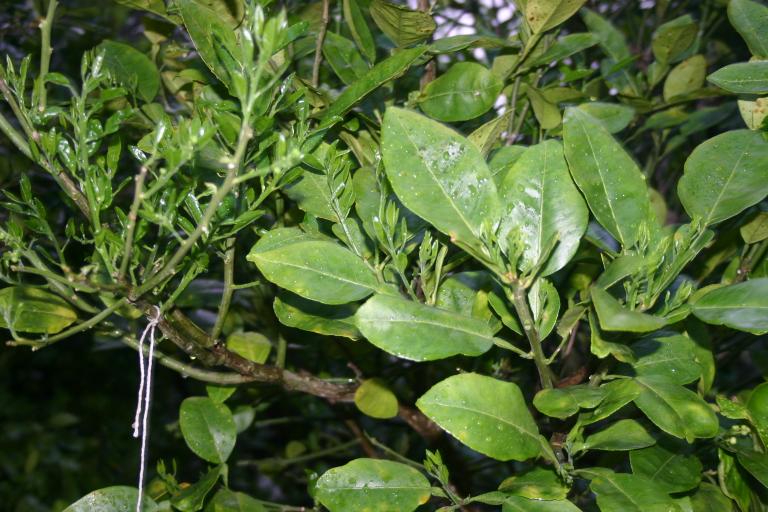
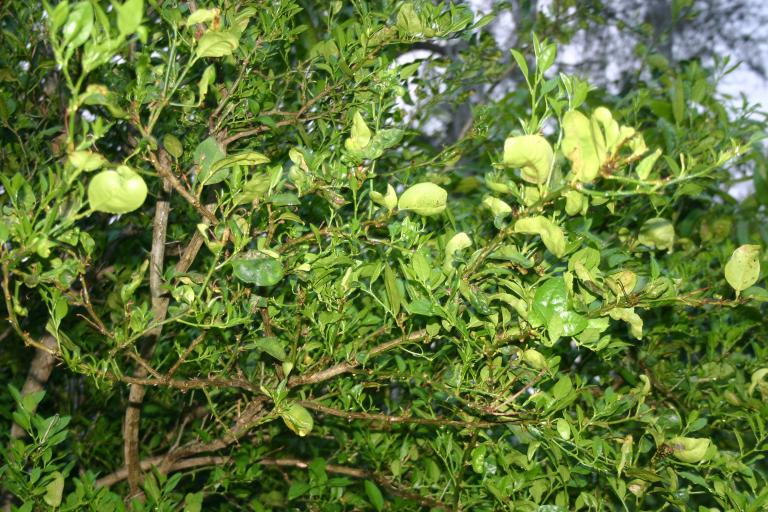
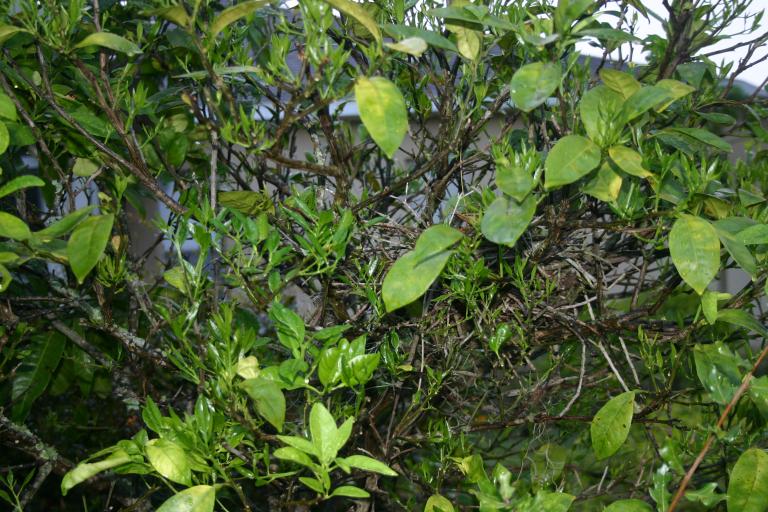

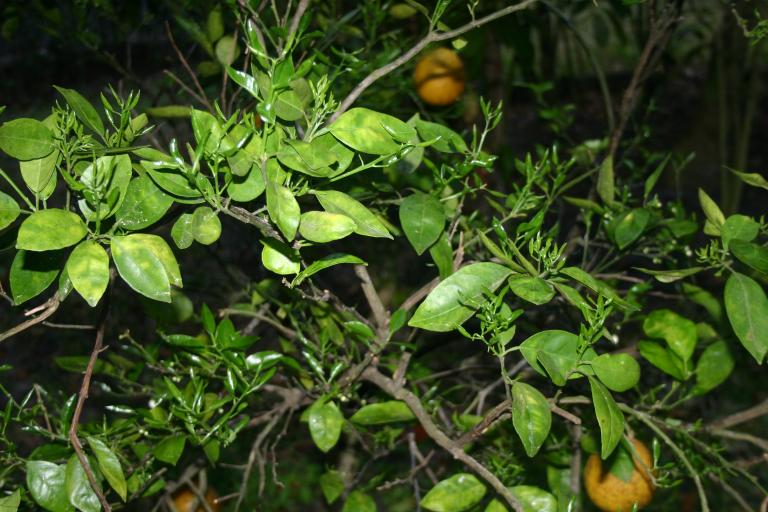
Part 1: “Citrus Greening Disease Observations”
by Dana Venrick
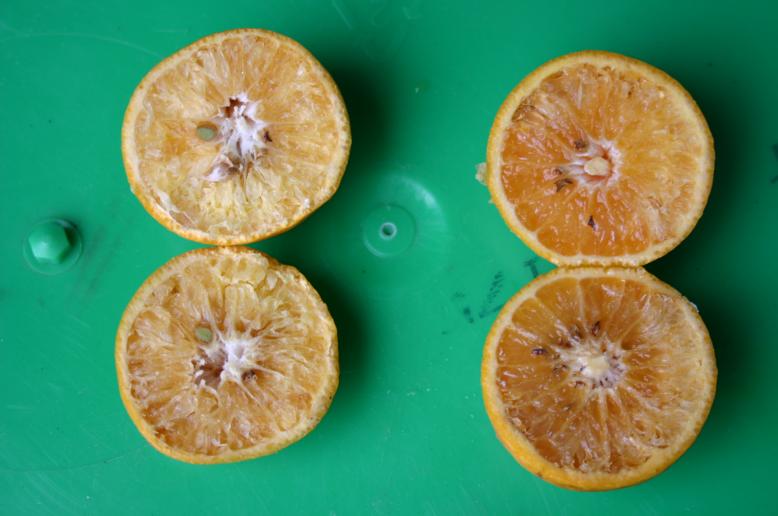
Symptoms of Greening/HLB Disease on two Mandarine Citrus fruit. Note the small, dark aborted seeds, the cut seed with a green interior, lots of dry, pithy sections, and a hollow heart (and very poor taste). Is it phosphorus and micronutrient deficiency, HLB Disease, or is it both?
So, what are the application rates for a typical spray program to remediate citrus Greening? Here are the application rates for Citra Thrive Plus & MZ Mix (organic manganese & zinc glucoheptonate) in a spray program to remediate Citrus Greening (HLB). The rates are 3 ounces per gallon or 3 gallons per 100 gallons of water per acre. The rate for the MZ Mix is one teaspoon per gallon or one pint per 100 gallons per acre. Be sure to fertilize with our special granular fertilizer for Citrus three times per season as well. When starting early in the year, apply the Citra Thrive Plus three months in a row at the 3 ounces per gallon rate (spray until run-off from the foliage and also spray the ground around the drip-line of Citrus trees). Then, spray three more times at the rate of 2 ounces per gallon. If starting now, spray in April, May, June at 3 ounces per gallon, then spray at 2 ounces per gallon in July and September. Add one teaspoon per gallon (one pint per acre) of MZ Mix for each of the spray applications. Also put one ounce per gallon (one gallon per acre) of Key Bor (organic boron) into the spray tank for the first spray of the year, and then 1/2 ounce per gallon (1/2 gallon per acre) of Key Bor into the spray tank for the September application.
One of the great ingredients in our Citra Thrive Plus is BioWash100. Here is an article posted on Florida Grower, Feb. 16, 2016 touting the benefits of BioWash:
January 16, 2016 3 Products To Better Serve Your Soil
Posted By: Paul Rusnak |
When it comes to growing produce, crop protection is of utmost importance in getting the harvest from the farm to the fork. It is known healthier plants can better stand up to pests and diseases. There are a number of products on the market geared toward soil health. Learn more about three currently on the market starting on this page.
1. BioWash
BioWash works at the cellular level of roots, increasing their ability to more efficiently absorb moisture and nutrients from the surrounding soil. Enhanced absorption of available carbon, humus, compost trace minerals, etc., increases the sugar content of the plant. The elevated brix count acts to improve photosynthesis, resulting in healthier growth and more hardy resistance to disease and climate impacts.
BioWash.info
***** Important Update: On July 21, 2014, Dana posted photographs the “Dana’s Daily Blog” page (second tab from top on the left side) showing dramtic evidence of how well our new blended spray material, we call Citra Thrive Plus, is working to remediate symptoms of Citrus Greening Disease. These are real time photos taken on the days noted with absolutely no changes made to the originals. Citra Thrive Plus is a real breakthrough in the battle to live with Citrus Greening by focusing on complete tree health and avoiding dangerous poisons that further weaken Citrus trees and harm the environment.
A Citrus grower was very concerned about a block of orange trees that were not looking good and he thought perhaps the trees had the Citrus Greening Disease (also called Huanglongbing or HLB). So we went to the grove to take a close look. After close inspection, I assured him the only strong visual symptoms were manganese (Mn) deficiency. I showed him the soil test taken a year earlier that indicated a strong Mn deficiency. No, the Mn deficiency has not been corrected. I pulled a soil sample and leaf tissue so that I can verify the Mn deficiency and see if the potassium (K), magnesium (Mg), silicon (Si – needed as silicon dioxide not oxide form like sand), and severe boron (B) deficiencies are still an issue as well. The bottom line is that there are not too many fruit and some of the fruit is smaller than normal as well. Undersized fruit is an indication of potassium deficiency in the tree. In fact, if only one essential element is severely lacking, tree growth, tree health, and fruit production will drop off rapidly as well.
There was no evidence of Greening. [***** Update: Since this was written, some of the trees started to show some of the Greening Disease symptoms listed below, which have since been remediated by spraying Quality Green’s Citra Thrive blend as recorded on “Dana’s Daily Blog” on July 21, 2014.] These are some of the symptoms that typically manifest with Greening: asymmetrical chlorosis (loss of chlorophyll in parts of leaves), distorted, lopsided fruit shape, an unpleasant bitter taste to the fruit, brown or aborted seeds, green colored interior of seeds, prouonced yellow, raised midribs, some green color remains on ripened fruit, and some fruit drop prematurely. Initial symptoms frequently include the appearance of yellow shoots in parts of a Citrus tree. Leaves displaying symptoms of Citrus Greening have a chlorotic appearance that differs from traditional nutrition-related mottling in that Greening-induced mottling usually crosses leaf veins.
I am convinced that nutrition plays a major role in the development of Greening. Very credible collaborative research by the U.S.D.A., University of Florida, University of California Riverside, and the country of China found that when Citrus trees have Greening, phosphorus (P) was about 35% deficient in the leaf tissue. [This indicates that nutrition is playing a major role and indicates the deficiency of or sequestration of phosphorus (tie-up) and various other minerals as well, e.g., when iron becomes too excessive in the soil (as when fertilizer with sludge filler is used, which has more iron than any other mineral, and iron is a micronutrient!), phosphorus and manganese may be tightly sequestered.] When the P level was increased in tree tissue, Greening symptoms were significantly reduced and fruit yield was increased. For a summary of the research, go to the article: “Study Links Citrus Greening Symptoms to Phosphorus Deficiency” at: http://www.greenbook.net/news/Study-links-
citrus-greening-symptoms-to-phosphorus-deficiency-193586601.html
This research and trials by Our company, Quality Green Specialists, Inc. and others have led to the development of our new 8-0-11 Energized Root Promoting Fertilizer. As you can see from the below label, this is a breakthrough formula utilizing the latest ENERGIZING technology. Potassium humate in the formulation is energized with an extra oxygen added to the molecules. The material becomes 100% water soluble, and the percentage of the actively available fulvic acid in the humate is increased to over 58% of the total! The phosphite/phosphate/potassium humate are combined with other minerals/activated nutritionals/sulfates and nine types of beneficial microorganisms to ensure optimum tree health. Along with our proprietary Citra Thrive Plus (with energized phosphite containing over 58% fulvic acid) optimum remediation of HLB is achieved.
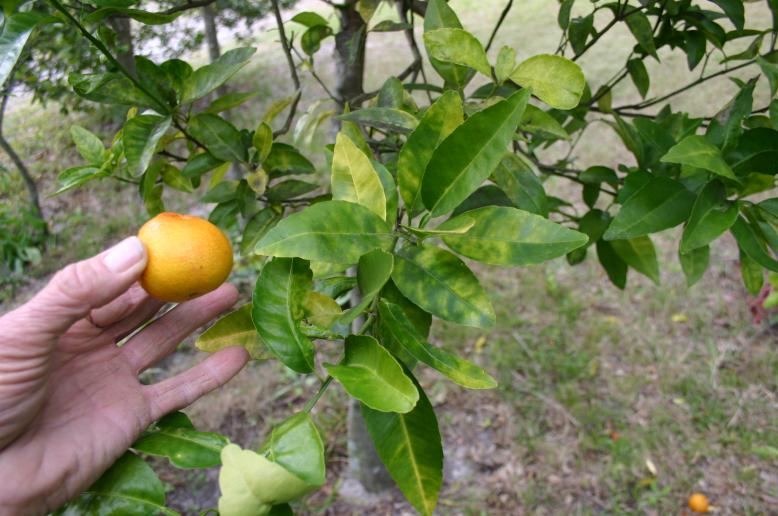
Above: Greening symptoms on fruit and leaves of a mandarine/tangerine Citrus at home in DeBary. Note the asymmetrical shape of the fruit and the asymmetrical mottling of the leaves. The tree will be sprayed soon with “Citra Thrive” [***** Note: These tree have been sprayed with Citra Thrive Blend, and as logged on “Dana’s Daily Log” on 7-21-14, there is dramatic recovery taking place.]
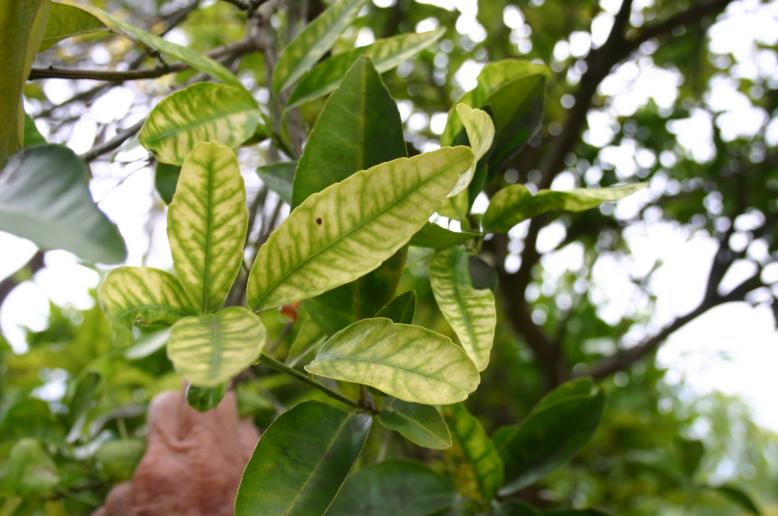
On the same tree, some branches have leaves with Greening symptoms, while leaves on other branches have nutrient deficiency symptoms. These leaves display strong micronutrient deficiency symptoms. These trees will be sprayed soon with Citra Thrive Plus. [***** Note: these trees were sprayed with Citra Thrive Blend on June 19, and as logged on “Dana’s Daily Blog” on July 21, 2014, dramatic recovery is taking place.]
Guess what? Greening symptoms mimic P deficiency. Perhaps the bacterium spread by the Citrus psyllid (a small insect) interferes with P biochemistry as well as other biochemical changes. Sometimes iron (Fe) is quite high, which could tie up P. Phosphorus can also be sequestered (tied up) by excessive magnesium (Mg) and other elements.
In one of my personal experiences, a grove with Greening symptoms, where I tested the soil and leaf tissue, had extremely high levels of boron (B) and Fe, both of which are elements that are very hard for the tree to mobilize (move from one part of the tree to another part when needed, e.g., to the new growth and developing fruit). Perhaps along with the Greening bacterium (Liberobacter spp.), the phloem tubes (sap conducting vessels carrying nutrients to various parts of a tree) become selectively clogged leading to the asymmetrical mottling (chlorosis) of the leaves as well as other symptoms that are often selective in expression. It turned out that Fe had been over-applied and B was included in the liquid fertilizer and was being applied by fertigation (liquid fertilizer application through the irrigation system) every two weeks. After hedging the trees in the grove and correcting the nutritional program (and spraying pesticides to keep the psyllid population low), the trees came back strong and are bearing lots of quality fruit.
I did some consulting for another large grower, Maury Boyd, who decided to try to bring his existing orange trees, which were diagnosed with a high level of Liberobacter bacterium, back to good health instead of intensive scouting, cutting, and burning the trees diagnosed with Greening. In 2006, 70% of Maury’s trees young trees and 43% of mature trees were PCR (polymerase chain reaction) identified as positive. He applied compost to his grove and elevated the potassium being applied in the dry, ground applications of fertilizer. Most of all, he transitioned to an intense liquid foliar fertilizer program, a liquid “cocktail” you might say. Some of the key ingredients included in his cocktail are humic acid, phosphorus acid/phosphite, and macronutrients (with more potassium than nitrogen)/micronutrients. With ground fertilization and this special cocktail, Maury Boyd says that the trees now produce the same fruit yields as before trees were infected with the Greening bacterium. High production levels have been maintained in spite of the grove going from a relatively low infection rate in 2006 to 95% of the trees being infected with the HLB bacterium in 2012.
For details of the cocktail Maury Boyd is using and how many fruit were produced on the Hamlin and Valencia oranges within the grove before and after Greening was confirmed in 2006 (and treatments were started), go to the following two websites:
http://conference.ifas.ufl.edu/citrus11/presentations/Friday/1000%20Spann.pdf
http://ashs.org/abstracts/2012/abstracts12/abstract_id_12222.html
A follow-up study by Bob Rouse, Associate Horticulture Professor at the University of Florida (UF) Southwest Florida Research and Education Center in Immokolee, with follow-up reseach, confirmed the positive results achieved by Maury Boyd. He also identified the key ingredients that were giving the positive results, including major elements, micronutrients, and phosphorus acid/phosphites. Another related experimental study by Ron Briansky, Professsor at the UF Citrus Research and Education Center in Lake Alfred, looked at clogged phloem within PCR positive trees. Briansky stained cross sections of vascular tisue and looked at the phloem tubes using a conventional light microscope. The phloem from the trees receiving the nutritional cocktail wasn’t nearly as plugged and tissue appeared to have new phloem being produced compared with the untreated trees. For a report on these research projects go to: http://www.thegrower.com/news/citrus-greening/Research-bolsters-foliar-nutrients-role-in-citrus-greening-management-131343848.html
There is no simple answer to any problem and it appears that spraying to keep the psyllid population low is important with most of the nutritional programs currently being implemented in the industry. The good news is that we now have lots of evidence and grower experience to show that good nutrition plays a major role in remediating Greening. Quality Green is working hard to develop an even better nutritional solution, one that does not require overloading the citrus trees with toxic pesticides and leaving excessive pesticide residues within the fruit. We are testing a liquid formulation we call “Citra-Thrive” that is designed to rescue Greening impacted trees, primarily with natural ingredients. We will keep you posted on the results of our trial treatments.
Research by the University of Florida IFAS (Institute of Food and Agricultural Sciences) by Tom Spann and others indicate that healthy trees given good, targeted nutritionals have SAR (systemic acquired resistance) to Greening and other diseases. In my opinion, if Citrus varieties are developed by genetic engineering that have built-in resistance to Greening, it will be more important than ever to support the genetically altered citrus trees with excellent nutrition.
Click on the link below for a study by the University of Florida IFAS on how Greening/HLB damages phloem and roots in sweet oranges while rough lemon is tolerant. Something that jumps out is on page 6, “It has been reported that HLB can restructure the bacterial community associated with sweet orange roots and in the rhizosphere (the bacterial community in the soil next to the roots).
The lack of sugars to the roots because of phloem blockage is sited. The lack of enough good bacteria in the sap and phloem tubes as well as excessive immobile mineral content as well as excesses of minerals in general and deficiencies of others may be the reason the HLB bacterium becomes dominant in the first place, just like a terrible unbalanced diet in people leads to digestive disorders and poor health.
Makes me think about human health and how a group of beneficial microflora such as Acidophilis (as found in yogurt) can dominate the harmful bacteria, keep them in check, and keep the intestinal track healthy. A wide range of health issues arise, besides poor digestion, when harmful bacteria dominate the intestinal track.
http://swfrec.ifas.ufl.edu/hib/database/pdf/13_Fan_13.pdf
Here is another excellent investigation by the University of Florida IFAS. Note in particular the last three paragraphs that show that the HLB bacterium does not plug the phloem tubes (the bacterium is too small and the individual bacterium do not aggregate), but the formation of callus tissue and “amorphous” material do clog the phloem tubes. Sounds like the formation of plaque on the arterial walls in response to diet and lifestyle.
Perhaps this explains why Maury Boyd took the same trees in his grove from 80% clogged phloem to 80% unclogged with his liquid foliar nutrition program and soil treatments. This was achieved in spite of the grove infection rate with the HLB bacterium going from 40% to 95% in 2012. This is more evidence that a quality nutrition program works and why our research and field trials with an even better liquid nutritional (Citra-Thrive) is so important and urgently needed.
http://www.crec.ifas.ufl.edu/academics/faculty/wang/PDF/PHYTO_99_1_0050_Microarray.pdf
More and more evidence is being found from research and field trials that nutrition is of utmost importance now that the HLB bacterium for convenience called Las (short for Candidatus Liberibacter asiaticus) is found in citrus trees and groves all over the state of Florida. An excellent article has been published in the January, 2014 issue of Citrus Industry magazine (for information about the magazine and archives go to: www.CitrusIndustry.net) entitled “What growers need to know about bicarbonates and root health”. The authors are Jim Graham, Evan Johnson, and Kelly Morgan. Jim Graham is a professor, Evan Johnson is a research assistant and Kelly Morgan is an associate professor, all with the University of Florida-IFAS. The following are excerpts regarding their findings from field trials and research.
I have previously noted an array of Greening (HLB) Disease symptoms. The authors also site the following: “Infected shoots are stunted and branches gradually die back as symptoms appear in other sectors of the tree canopy. Evacuation of the soil-root zone in the wetted area under the canopy reveals a deficit of fibrous roots compared to an apparently healthy tree. Yield is reduced directly by the root loss, which leads to fruit drop and eventually to tree decline. HLB reduces fruit size [so does potassium/K deficiency], weight and other fruit quality variables, such as total soluble solids (TSS) content, acidity, and TSS/acidity ratio.”
Continuing, “In recent seasons, concurrent with freeze and drought episodes, symtomatic HLB-infected trees have been much more affected by the extremes of temperature and moisture than trees without HLB. Symptoms….are typical of nutrient and water-stressed trees with reduced vigor and excessive leaf loss followed by premature fruit drop even when trees are managed with good nutritional and irrigation practices recommended to support health of HLB-infected trees. Stress intolerance of HLB [infected] trees is a direct consequence of more than a 30 percent loss of fibrous root density compared to non-diseased trees. …..When Las interacts with [the root pathogen] Phytophthora [in an undesirable way], fibrous root loss can be greater than that caused by HLB alone, depending on the grove location and time of the year.
….it is highly likely that Las damage alters the concentration of soluble sugars in roots by increasing leakage from roots that attracts and accelerates infection by root pathogens such as P. [Phytophthora] nicotianae.”
The authors note that rootstocks vary in their response to Las infection. I previously sited research demonstrating that rough lemon rootstock has tolerance to infection by Las.
Continuing, “Given the large deficit in roots of HLB affected trees, it is imperative to maximize the functioning of the remaining roots for nutrient and water uptake while minimizing root stresses. One such stress, bicarbonates in soil, went unrecognized in citrus groves for decades until HLB incidence increased and trees began to show symptoms of stess in groves state wide. Carbon species in water depends on pH: Carbonic acid (H2CO3) is the predominant form at pH less than 6.5; bicarbonate (HCO3-) forms at pH range from 6.5 to 8.5; and carbonate (CO3-2) forms at pH greater than 8.5 [a chart is referenced]. Extensive surveys of HLB-affected groves indicate that where irrigation water is high in bicarbonates (greater than 100 ppm) and/or soil pH (greater than 6.5) there is greater decline in root health and higher expression of HLB symptoms. Typically, affected groves are under microjet irrigation that concentrates fibrous roots in the wetted zone, and soils have a history of excessive dolomite liming to manage issues such as high residual copper.”
“Soils statewide have increased in pH and bicarbonate concentrations in recent decades due to irrigation with alkaline water from deep wells extending into Florida’s limestone aquifers. As soils become more alkaline, some nutrients become more available (e.g., N and Mg) for uptake by plants, and others (e.g., Fe, Mn, Zn and B) become less available for uptake. Groves with soil pH greater than 6.5 and/or well water bicarbonate greater than 100 ppm often have off-color foliage, thin canopies due to excessive leaf drop, twig dieback and more severe HLB symptoms in leaves and fruit.”
“Furthermore, HLB symptom expression of trees on different rootstocks ranks Swingle greater than Carizzo, Carrizo greater than sour orange, and sour orange greater than Cleopatra – which follows their known intolerance of bicarbonate.”
“We hypothesize that groves with high bicarbonate stress are suffering from HLB because they support lower root density compared to groves with lower bicarbonates (less than 100 ppm in irrigation water and/or soil pH (less than 6.5).” The authors continued to say that this relationship was confirmed in a survey of 37 groves in Highlands and DeSoto counties with varying liming history and deep vs. shallow wells mostly on Swingle and Carrizo rootstocks. “Lower root density is significantly related to well water pH greater than 6.5 and to soil pH greater than 6.2. Yield records….also indicate that groves under high bicarbonate stress production have declined 20 percent over the last three seasons (2009-2012) in contrast to Ridge groves with low bicarbonate stress, which have increased 6 percent even though HLB incidence has accelerated [this is illustrated in a table].”
Let us stop here for a moment. This is pretty amazing that when the bicarbonate stress is off, production increases in spite of HLB infection increase and, no doubt, many other stresses. So, is the real problem the Las bacterium infection of the tree or is it more of a problem of a very poor mineral uptake profile caused more by bicarbonate and other stresses than by Las and other stresses? Seems to me to be a very serious question. Perhaps undue blame is being placed on the psyllid insect and the Las bacterium infecting Citrus trees in the state of Florida.
Continuing in the same paragraph: “The yield losses are correlated with less fibrous root density [perhaps caused more by the high bicarbonate than by the Las?], which reduces root system capacity for water and nutrient uptake. Evidence from research on other crops indicate that bicarbonate impairs the root’s ability to take up important nutritional cations, including Ca, Mg and K, as well as micronutrients, especially Mn and Fe. [Perhaps phosphorus (P) as well. Remember the research I sited by the University of Florida – IFAS, University of California Riverside, the U.S.D.A. and the country of China that showed a correlation between at least a 35% deficiency of P and the symptoms of HLB and the remission of symptoms when P was corrected to optimum levels. This, again, is very credible evidence that HLB may be more of a cultural/nutritional problem rather than primarily a pathogen-caused disease. Phosphorus has been over-applied in many cases over the years to citrus groves, it leaches from the soil very poorly, and (at higher soil levels) can be strongly tied up with iron (Fe) and other elements such as magnesium (Mg). Remember that there is more Mg available in the soil at a higher pH, but then there could be some sequestration (tie up) with P in the soil. Then multiple tie-ups of P, Mg, Fe, Mn, Zn, B, and others may be occuring. Not to mention possible toxic levels in tree tissue of some elements such as B from over-application of liquid foliar nutritionals. Both Fe and B are very hard for a tree to mobilize (move) in a tree from older tissue to new, growing tisue and at excessive levels could be contributing to Phloem tube clogging. Of course, many Citrus fertilizers in recent years have been formulated with no P and, if there has not been frequent soil testing and if P is low and if no P is added, of course P is low in the trees tissue, making another serious nutritional stress factor. Then too, many dry Citrus fertilizers have limited micronutrients included as oxide forms, which are basically very poorly available forms of trace elements. Also, many fertilizers have a high percentage of sludge (bio-solids) filler, which is very high in Fe. High Fe can readily ties up both P and Mn.]
At the very least, we are talking about the urgent need to get a lot more serious about good, bio-available nutrition to Citrus trees. Furthermore, both regular soil testing and paste extract soil testing need to done on a regular basis, at least yearly. Traditional soil testing gives a measure of the total amount of minerals in the soil colloidal complex, while a quality saturated paste extract soil test shows the level of bicarbonates, pH, soluble salts, chlorine, and the total amount of each of the tested minerals that are actually dissolved in the soil water solution and are available to the fibrous root system. We feel that our soil testing, utilizing either or both methods, our tissue testing, and water testing combined are the best in the business. Especially when you consider my detailed analysis and recommendations to move the Citrus grove toward optimum levels of all the minerals in the soil and in the Citrus tree. That is when you will see remarkable tree recovery if the tree decline has not advanced too far.

